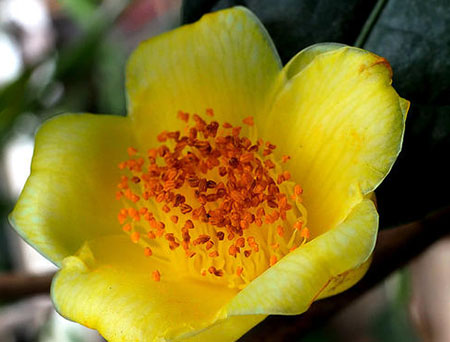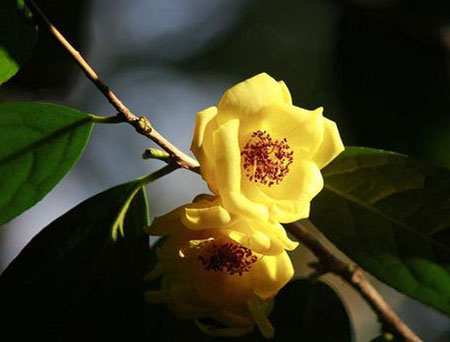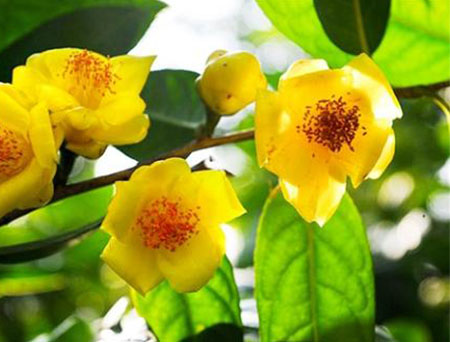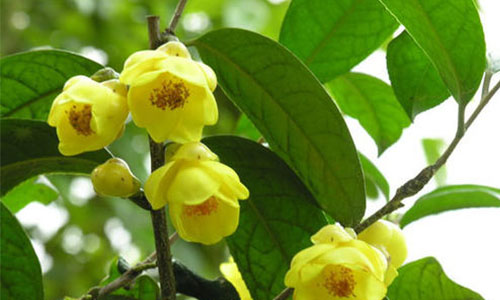Camellia nitidissima Chi profile
Written by Maggie
Nov 12 2020

Camellia nitidissima Chi belongs to the Camellia family and the genus Camellia. It is twin sisters with tea, camellia, southern camellia, camellia oleifera, tea plum, etc. It is a national first-class protected plant. It was first discovered by Chinese botanist Zuo Jinglie on July 29, 1933 in Achi Pass, Dacai Township, Fangcheng County, Guangxi. It was officially named "Camellia nitidissima C.W.Chi" by Chinese botanist Qi Jingwen in 1948. It is called the miraculous oriental magic tea abroad, and it is called "the giant panda of the plant kingdom".
The flower of camellia nitidissima Chi is golden yellow, dazzling, as if coated with a layer of wax, crystal clear and oily, seemingly translucent. Camellia tea grows solitary in the leaf axils. When the flowers bloom, they are cup-shaped, pot-shaped or bowl-shaped. They are beautiful and elegant. Has the reputation of "Tea Queen".
Camellia nitidissima Chi picture

Morphological characteristics, growth habits and distribution of Camellia nitidissima Chi
Morphological characteristics of Camellia nitidissima Chi
Camellia nitidissima Chi belongs to the Camellia family, Camellia genus, shrubs. It is 2 to 3 meters high, and the shoots are glabrous. The leaves are leathery, oblong or lanceolate, or oblanceolate, 11-16 cm long and 2.5-4.5 cm wide. Apex caudate acuminate, base wedge-shaped, dark green above, shiny, glabrous, light green below, glabrous, with black gland spots, 7 pairs of mid and lateral veins, sunken on the top, protruding below, with thin edges Serrated, the teeth are carved 1 to 2 mm apart, the petiole is 7 to 11 mm long, and is glabrous.
Morphological characteristics of Camellia nitidissima Chi Flower yellow, axillary, singular, flower stalk 7-10 mm long; 5 bracts, scattered, broadly ovoid, 2-3 mm long, 3-5 mm wide, persistent; 5 sepals , Ovoid to round, 4-8 mm long, 7-8 mm wide, slightly contiguous at the base, rounded at the apex, slightly hairy on the back; 8-12 petals, nearly round, 1.5-3 cm long, 1.2~2 cm wide, slightly connected at the base, with eyelashes on the edge; stamens arranged in 4 rounds, outer ring and petals are slightly connected, filaments are nearly free or slightly connected, glabrous, 1.2 cm long; ovary glabrous, 3 ~4 compartments, 3~4 styles, glabrous, 1.8 cm long.
Camellia nitidissima Chi morphological characteristics. Capsules are flat triangular and spherical, 3.5 cm long, 4.5 cm wide, with 3 lobes dehiscent, 4-7 mm thick, 3 to 4 angular central axis, 3 to 4 lobed apex; fruit stalk length 1 cm, There are persistent bracts and sepals; 6 to 8 seeds, about 2 cm long. Flowering from November to December.
Camellia nitidissima Chi growth habit and distribution
The morphological characteristics of Camellia nitidissima Chi like a warm and humid climate, and an acidic soil with good drainage. It likes shade in the seedling stage, and it likes to transmit sunlight after it enters the flowering stage. The soil requirements are not strict, and it can grow in slightly acidic to neutral soil. Tolerant to infertility, but also like fat. Strong waterlogging tolerance.
The morphological characteristics of Camellia nitidissima Chi is an ancient plant, extremely rare and extremely narrow in distribution. The 90{bf} wild camellia in the world is only distributed in the Lanshan branch of Shiwanda Mountain, Fangchenggang City, Guangxi, China, growing at an altitude of 700 meters Below, the range between 200 and 500 meters above sea level is more common, and the lower limit of the vertical distribution is about 20 meters above sea level. For example, Camellia is still distributed in the coastal hilly terraces near the Dawang River in Fangcheng County. The upper limit of the vertical distribution can reach 890 meters above sea level. For example, the morphological characteristics of individual small petals Camellia nitidissima Chi can still be seen in the Natao Mountain in Ningming County, and the number is very small. It is a rare and precious plant in the world.
Camellia nitidissima Chi main value
Scientific research value
The morphological characteristics of Camellia nitidissima Chi have a special color genetic DNA, which is difficult to replicate for reproduction. The use of high technology to solve the rapid propagation of Camellia nitidissima Chi morphological characteristics of a variety of excellent seedling survival genes, to overcome the difficult problem of low survival; breakthrough the key technology of Camellia nitidissima Chi morphological characteristics of slow growth and low yield, greatly increasing the large-scale planting of Camellia nitidissima The output of Chi morphological characteristics; the in-depth development of Camellia nitidissima Chi morphological characteristics of a new generation of world-class medical and healthcare products that benefit human health are of great scientific research value.
Medicinal value
According to the joint inspection of many domestic authorities, Camellia nitidissima Chi has a non-toxic morphological characteristic, contains more than 400 nutrients, and has no toxic side effects. Camellia nitidissima Chi is rich in tea polysaccharides, tea polyphenols, total saponins, total flavonoids, tea pigments, caffeine, protein, vitamin B1, B2, vitamin C, vitamin E, folic acid, fatty acids, B-carotene, etc. Natural nutrients; Camellia nitidissima Chi contains dozens of amino acids such as theanine and threonine, and is rich in a variety of natural organic germanium (Ge), selenium (Se), and molybdenum ( Trace elements such as Mo), zinc (Zn) and vanadium (V), and macro elements such as potassium (K), calcium (Ca) and magnesium (Mg).

The effect of Camellia nitidissima Chi morphological characteristics:
The morphological characteristics of Camellia nitidissima Chi have obvious effects of lowering blood sugar and urine sugar, and can effectively improve the symptoms of diabetes "three highs". The morphological characteristics of Camellia nitidissima Chi can effectively lower blood sugar and blood pressure, while reducing blood lipids, improving various maladaptive symptoms caused by high blood pressure, lowering serum cholesterol and B-lipoprotein, promoting insulin secretion, enhancing immunity, Regulate blood flow, prevent atherosclerosis, anti-bacterial and anti-inflammatory, clearing away heat and detoxification, improving liver metabolism, preventing cancer and inhibiting tumor growth, etc.
The morphological characteristics of Camellia nitidissima Chi have unique and magical effects on lowering blood sugar, lowering blood pressure, lowering blood lipids, and lowering cholesterol, and have a unique and magical effect on diabetes and its complications.
Ornamental value
The discovery of the morphological characteristics of Camellia nitidissima Chi fills the gap that the Camellia family does not have golden flowers. Its waxy green leaves are crystal clear and clean, the petals are transparent, firm and smooth, and spotless; the buds are round and golden; the petals are overlapped and dense, fresh and beautiful, dotted among the jade leaves and Qiong branches, graceful, graceful, golden petals and jade stamens, beautiful and beautiful People, pleasing to the eye, and its viewing value is unparalleled.
Economic Value
The morphological characteristics of Camellia nitidissima Chi have very high economic value. First, the appreciation of flowers is expensive. The price of a bonsai with a height of 1 to 1.5 meters and a better shape is 8,000 yuan; about 2 meters in height, the price ranges from 26,000 to tens of thousands; Japan once wanted to buy a Chinese bonsai for 25,000 US dollars. Second, Camellia nitidissima Chi has a very high added value of morphological characteristics. Products produced through industrialized deep processing have been recognized and favored by consumers, and their prices have risen steadily. In particular, the price of scented tea is considerable, and the supply is in short supply.
Species protection measures
It is as famous as the precious "living plant fossils" such as silver fir, Alsophila spinulosa and Davidia involucrata. It belongs to the plant species in Appendix II of the Convention on International Trade in Endangered Species of Wild Fauna and Flora. It is called the miraculous oriental magic tea abroad and is known as the "plant kingdom". "Giant Panda", "Tea Queen". In order to make this national treasure multiply, Chinese scientists are working together to carry out cross-breeding experiments to breed more excellent varieties. It has been introduced and cultivated in Kunming, Hangzhou, Shanghai and other places in China.
Cultivation Techniques of the Morphological Characteristics of Camellia nitidissima Chi
1. Growth environment
The morphological characteristics of Camellia nitidissima Chi like to be born in a half-shady, half-cool, humid environment, and need regular ventilation, especially in the north. In addition to boilers and radiators for heating, the glass heating cellar is also equipped with self-made atomizers, ventilation fans and other facilities.
2. Planting management
The soil uses proportioned pine needle soil to gradually remove the "yellow mud" brought by the south.
The water used for watering the flowers must be added with 1{bf} ferrous sulfate each time, so that the water always maintains a certain degree of weak acidity.
Control the temperature. The temperature difference should be between 7℃ and 10℃. When the cellar temperature is 20℃, put down the shading cloth after four or five hours and ventilate immediately.
Fertilization, one is diluted yogurt, this method does not need to be fermented and can be used directly, and the other traditional method is fermented soybean cake water. Fertilize once a month.
3. Reproduction
Sowing and propagation: Camellia nitidissima Chi morphological characteristics The fruit generally matures in early and mid-October and cracks in late October. There is no post-ripening dormancy period after the seeds mature. Seed propagation is suitable for autumn sowing. In early and mid-October, place the harvested fruits in a ventilated indoor place to dry in the shade. After the capsules crack and take out the seeds, sow them immediately. If it is not possible to sow in autumn, the seeds should be stored in wet sand for spring sowing in February of the following year.
Cutting propagation: Camellia nitidissima Chi morphological characteristics Cutting propagation is suitable from April to early May, and it can also be carried out in mid and late September. For cuttings, select the semi-mature branches of the current year with full crown outer tissues, complete leaves, full leaf buds and no pests and diseases. The key to the survival of tea seedling cuttings is to maintain sufficient humidity in the early stage of seedling raising, avoid direct sunlight, and control the temperature at about 25°C. Spray water frequently so that the seedlings are often covered with a thin water film. One month later, when new roots have grown, gradually increase sunlight to accelerate the lignification of tea seedlings.
Grafting propagation: Camellia nitidissima Chi morphological characteristics Grafting propagation is divided into sprout root grafting and semi-mature branch grafting. Sprout anvil grafting. Rootstocks can be ordinary single camellia and camellia. The rootstock seeds are first sown on a sand bed, and the seedlings can be grafted when they grow to 4 to 5 cm. Before grafting, dig the rootstock sprouts, remove the clean sand, and cut them 1 to 1.5 cm above the cotyledons, and cut off the root tip to make the total length 6 to 7 cm; select well-growing semi-lignified branches As a scion, cut it into a wedge shape and put it in a wet towel to moisturize.
When grafting, the morphological characteristics of Camellia nitidissima Chi sprouts are split along the cotyledon line and the stem is cut longitudinally, the depth is the same as the bevel cut by the scion, and the cut scion is quickly inserted into the cleave of the rootstock, aiming at the cambium on the side of the stock. Tie tightly with plastic film tape. Then, the grafted seedlings of Camellia nitidissima Chi with morphological characteristics were planted in a fertile, loose sandy soil seedbed at a spacing of 8×2 cm. After planting, use plastic film to keep warm in the seedbed. Generally, the grafted seedling interface begins to heal in 10 to 15 days, and the film can be uncovered at night in about 20 to 25 days. Then gradually strengthen the ventilation and increase the light. After the buds germinate, all the film is removed.

4. Flowering management
The morphological characteristics of Camellia nitidissima Chi generally bloom after 3 to 5 years of planting. Yellow buds usually appear in July to August each year. At this time, some weak-branch buds, inward buds, over-dense buds and deformed buds can be removed. Concentrate nutrients, make the flower distribution reasonable, bloom bigger, and prolong the flowering period. Camellia nitidissima Chi's morphological characteristics were fully opened in November, and it opened until March of the following year, with a full blooming period of 1 to 2 months.
5. Pest control
The common diseases of adult Camellia nitidissima Chi include anthracnose, soot, leaf blight, bud blight and so on.
Anthracnose is a common disease with the morphological characteristics of Camellia nitidissima Chi. The lesions start from the tip or edge of the leaf. The lesions are irregular, often with small black spots on it, and the healthy part is obvious. Usually use 70{bf} thiophanate-methyl diluted 800 times for foliar spray at the early stage of the disease, once every 5 to 7 days, spray 3 times. The amount of spraying is 60 kg per mu.
The symptoms of soot disease are coal contamination on the leaves. The bacteria also harm the branches and young shoots. In severe cases, the branches and leaves are covered with a black coal layer, which hinders the normal photosynthesis of plants.
The main insect pests are aphids, which can be controlled by spraying with 50{bf} dimethoate emulsion 1000 times.
Tea budworms, leaf rollers, tea tussock moths, etc. are common pests with the morphological characteristics of Camellia nitidissima Chi. Tea aphids and leaf rollers can cause the morphological characteristics of Camellia nitidissima Chi leaves to curl and shrink and cannot stretch. Tea poison moth bites the leaves into missing pieces, or eats up all of them, which seriously affects the growth of the plant. The prevention and control should be carried out as soon as possible. You can choose to spray 800 times the chrysanthemum cream with high efficiency, low toxicity and low residue.
Latest Updated
- Benefits of Bugleweed - 7 Science-backed Health Benefits
- Bugleweed Dangers & Side Effects - Is It Poisonous?
- How to Plant Evergreen Trees - What You Should Know
- When to Plant Evergreens - Grow Guide for Evergreen Trees
- 12 Wonderful Evergreen Shrubs for Your Garden
- 12 Popular Evergreen Plants with Pictures for Beginners
- When And How To Prune A Lilac Bush Like a Pro
- How to Grow & Care for Lilac Vine (Hardenbergia Violacea)
- Japanese Lilac Tree (Syringa Reticulata) Care & Propagation Guide
- Shumard Oak Pros and Cons - What to Know
Popular Articles
- Winter maintenance of Antirrhinum Majus
- How to Grow Terminalia Mantaly Tree
- How to Grow and Care for Crossostephium Chinense
- How to grow Antirrhinum Majus in spring
- Peristeria Elata (Dove Orchid) Profile: Info & Care Guide
- Underwatered Snake Plant (Sansevieria Trifasciata) - Signs And How To Fix
- How to Care for Brazilian Jasmine Plant (Mandevilla Sanderi)
- How to Grow & Care for Graptopetalum Purple Delight in Summer
- Rosa Chinensis (China Rose): Plant Growing & Care Tips
- How to Care for Baby Sun Rose (Aptenia Cordifolia)